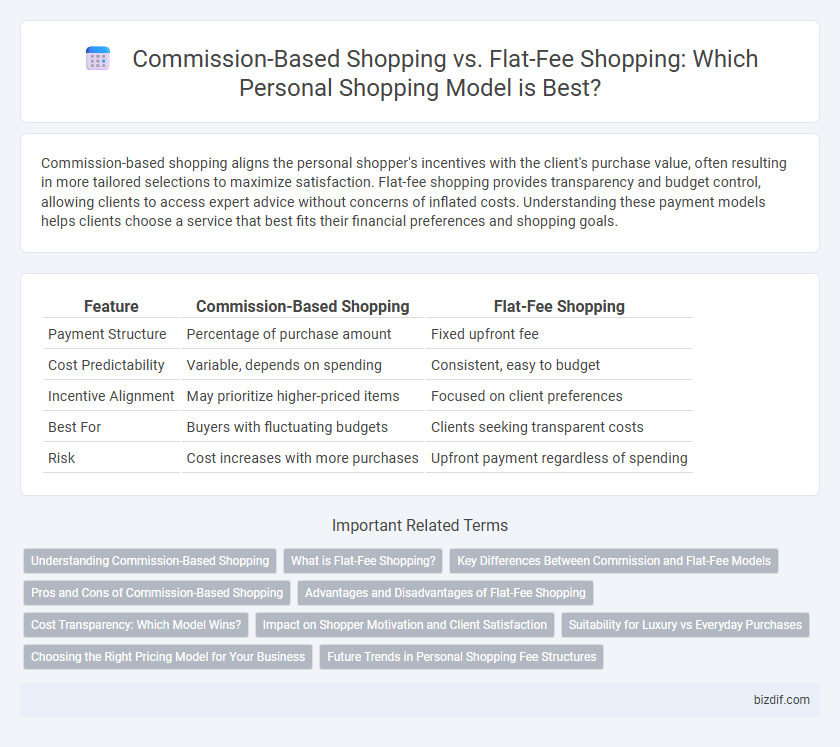Commission-based shopping aligns the personal shopper's incentives with the client's purchase value, often resulting in more tailored selections to maximize satisfaction. Flat-fee shopping provides transparency and budget control, allowing clients to access expert advice without concerns of inflated costs. Understanding these payment models helps clients choose a service that best fits their financial preferences and shopping goals.
Table of Comparison
| Feature | Commission-Based Shopping | Flat-Fee Shopping |
|---|---|---|
| Payment Structure | Percentage of purchase amount | Fixed upfront fee |
| Cost Predictability | Variable, depends on spending | Consistent, easy to budget |
| Incentive Alignment | May prioritize higher-priced items | Focused on client preferences |
| Best For | Buyers with fluctuating budgets | Clients seeking transparent costs |
| Risk | Cost increases with more purchases | Upfront payment regardless of spending |
Understanding Commission-Based Shopping
Commission-based shopping involves paying a percentage of the total purchase price to the personal shopper as their fee, aligning their earnings with the amount spent. This model incentivizes the shopper to find higher-value or more premium items tailored to the client's preferences. Understanding commission-based shopping helps clients anticipate variable costs and evaluate the benefits of personalized service linked to purchase volume.
What is Flat-Fee Shopping?
Flat-fee shopping is a personal shopping service where clients pay a fixed price regardless of the total amount spent, offering transparent and predictable costs. This model eliminates uncertainty over commissions, allowing shoppers to budget easily without worrying about percentage-based fees. Clients benefit from customized assistance and curated selections while maintaining control over their shopping budget.
Key Differences Between Commission and Flat-Fee Models
Commission-based personal shopping charges a percentage of the total purchase price, incentivizing shoppers to find higher-value items, while flat-fee shopping involves a fixed cost regardless of spending, offering transparent pricing and budget predictability. Commission models can lead to higher overall costs for expensive purchases due to percentage fees, whereas flat-fee models benefit clients making numerous or large transactions by capping service expenses. Both structures affect shopper motivation and client budgeting, making the choice dependent on purchasing habits and financial preferences.
Pros and Cons of Commission-Based Shopping
Commission-based shopping offers personalized service by aligning the shopper's incentives with the client's purchase decisions, often resulting in tailored recommendations and attentive support. However, this model can lead to higher overall costs for clients due to percentage-based fees and potential conflicts of interest, as shoppers might prioritize higher-priced items to increase their commission. Clients seeking transparency and fixed expenses may find flat-fee shopping more predictable, contrasting with the variable nature of commission-based pricing.
Advantages and Disadvantages of Flat-Fee Shopping
Flat-fee shopping offers predictable costs, allowing customers to budget effectively without worrying about escalating charges based on purchase amounts or complexity. However, it may lead to overpaying when services are minimal or simple, reducing cost-efficiency compared to commission-based models that align fees with purchase volume. Clients benefit from transparent pricing but must assess whether the flat fee justifies the value and personalized attention they receive during their shopping experience.
Cost Transparency: Which Model Wins?
Commission-based shopping often lacks cost transparency as fees are a percentage of the purchase price, sometimes hidden in product costs, leading to unpredictable expenses. Flat-fee shopping provides clear, upfront pricing regardless of purchase size, ensuring shoppers know exactly what they will pay before services begin. This model typically wins in cost transparency by offering straightforward, fixed fees that prevent unexpected charges.
Impact on Shopper Motivation and Client Satisfaction
Commission-based shopping incentivizes shoppers to prioritize high-value or premium products, often enhancing motivation through potential earnings but risking biased recommendations that may affect client trust. Flat-fee shopping fosters impartiality by rewarding shoppers equally regardless of purchase price, increasing client satisfaction due to perceived objectivity and personalized attention. Balancing these models influences shopper engagement quality, directly impacting client experience and retention rates.
Suitability for Luxury vs Everyday Purchases
Commission-based shopping suits luxury purchases by aligning the shopper's incentives with the value of high-end items, often resulting in personalized service and exclusive access. Flat-fee shopping is better tailored for everyday purchases, providing predictable costs and streamlined service without the complexity of variable commissions. Luxury buyers favor commission models for bespoke experiences, while casual shoppers benefit from flat fees for routine or budget-conscious shopping.
Choosing the Right Pricing Model for Your Business
Choosing the right pricing model for your personal shopping business depends on client preferences and service scope; commission-based shopping aligns with purchases made, incentivizing higher sales volume, while flat-fee shopping offers predictable costs and consistent revenue regardless of order size. Commission-based models work well for luxury or bespoke items where purchase prices vary significantly, whereas flat-fee structures suit clients seeking budget clarity and straightforward billing. Evaluating your target market's purchasing behavior and spending habits ensures the optimal balance between profitability and client satisfaction.
Future Trends in Personal Shopping Fee Structures
Future trends in personal shopping fee structures reveal a shift towards hybrid models combining commission-based and flat-fee approaches to offer greater transparency and flexibility. Advances in AI and data analytics enable personalized fee adjustments based on shopper preferences, purchase patterns, and service complexity. This evolving landscape enhances customer trust and satisfaction by aligning pricing with value delivered, fostering long-term client relationships.
Commission-based shopping vs Flat-fee shopping Infographic

 bizdif.com
bizdif.com